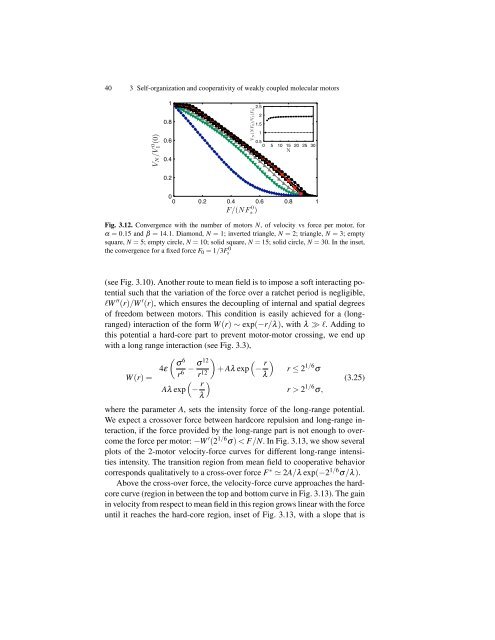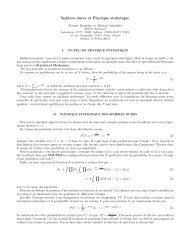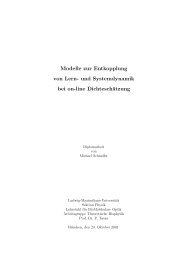Thesis (pdf) - Espci
Thesis (pdf) - Espci
Thesis (pdf) - Espci
You also want an ePaper? Increase the reach of your titles
YUMPU automatically turns print PDFs into web optimized ePapers that Google loves.
40 3 Self-organization and cooperativity of weakly coupled molecular motors<br />
VN/V 0<br />
1 (0)<br />
1<br />
0.8<br />
0.6<br />
0.4<br />
0.2<br />
0.5<br />
0 5 10 15<br />
N<br />
20 25 30<br />
0<br />
0 0.2 0.4 0.6 0.8 1<br />
F/(NF 0 s )<br />
Fig. 3.12. Convergence with the number of motors N, of velocity vs force per motor, for<br />
α = 0.15 and β = 14.1. Diamond, N = 1; inverted triangle, N = 2; triangle, N = 3; empty<br />
square, N = 5; empty circle, N = 10; solid square, N = 15; solid circle, N = 30. In the inset,<br />
the convergence for a fixed force F0 = 1/3F 0<br />
s<br />
(see Fig. 3.10). Another route to mean field is to impose a soft interacting potential<br />
such that the variation of the force over a ratchet period is negligible,<br />
ℓW ′′ (r)/W ′ (r), which ensures the decoupling of internal and spatial degrees<br />
of freedom between motors. This condition is easily achieved for a (longranged)<br />
interaction of the form W(r) ∼ exp(−r/λ), with λ ≫ ℓ. Adding to<br />
this potential a hard-core part to prevent motor-motor crossing, we end up<br />
with a long range interaction (see Fig. 3.3),<br />
<br />
σ 6 σ 12<br />
4ε −<br />
W(r)= r6 r12 <br />
+ Aλ exp − r<br />
<br />
r ≤ 2<br />
λ<br />
1/6 σ<br />
<br />
Aλ exp − r<br />
<br />
r > 2<br />
λ<br />
1/6 (3.25)<br />
σ,<br />
where the parameter A, sets the intensity force of the long-range potential.<br />
We expect a crossover force between hardcore repulsion and long-range interaction,<br />
if the force provided by the long-range part is not enough to overcome<br />
the force per motor: −W ′ (2 1/6 σ) < F/N. In Fig. 3.13, we show several<br />
plots of the 2-motor velocity-force curves for different long-range intensities<br />
intensity. The transition region from mean field to cooperative behavior<br />
corresponds qualitatively to a cross-over force F ∗ 2A/λ exp(−2 1/6 σ/λ).<br />
Above the cross-over force, the velocity-force curve approaches the hardcore<br />
curve (region in between the top and bottom curve in Fig. 3.13). The gain<br />
in velocity from respect to mean field in this region grows linear with the force<br />
until it reaches the hard-core region, inset of Fig. 3.13, with a slope that is<br />
VN (NF0)/V1(F0)<br />
2.5<br />
2<br />
1.5<br />
1




